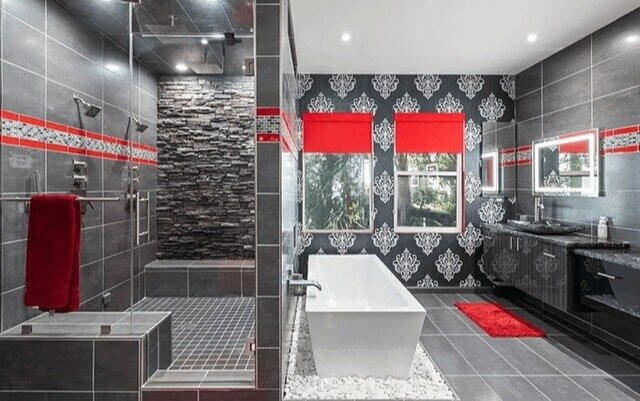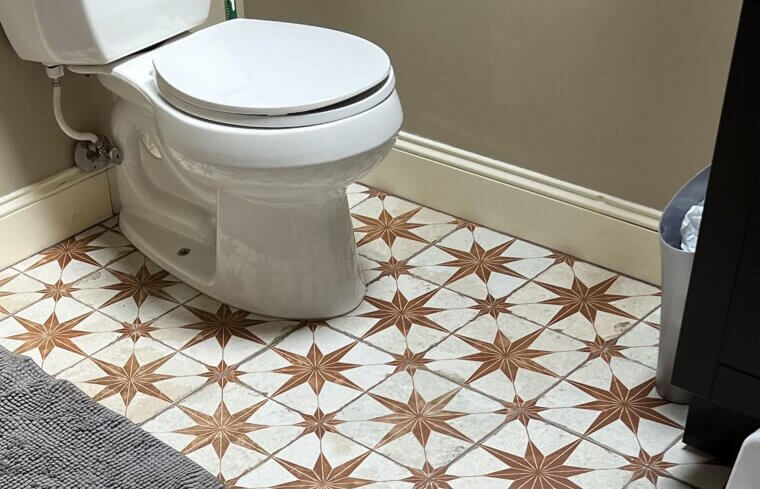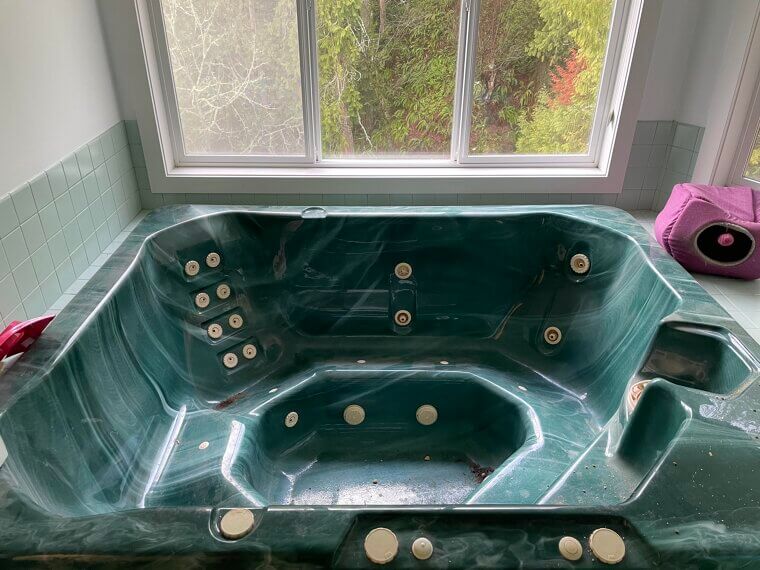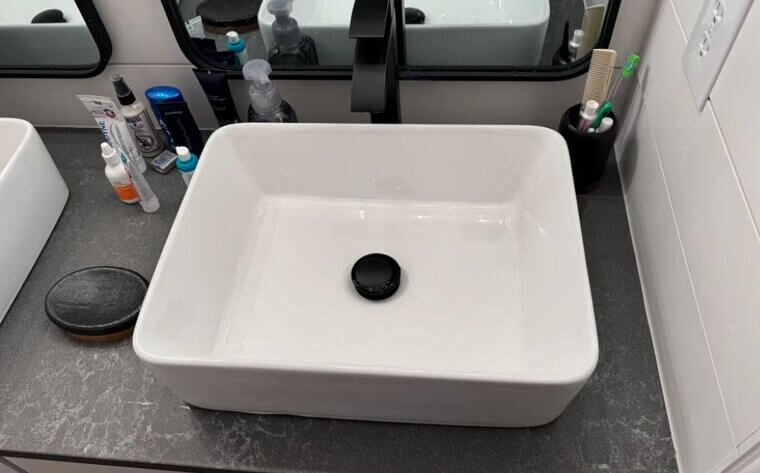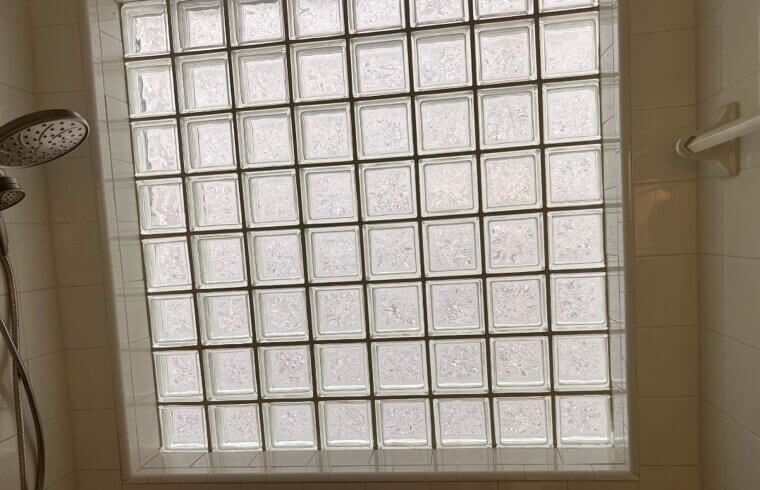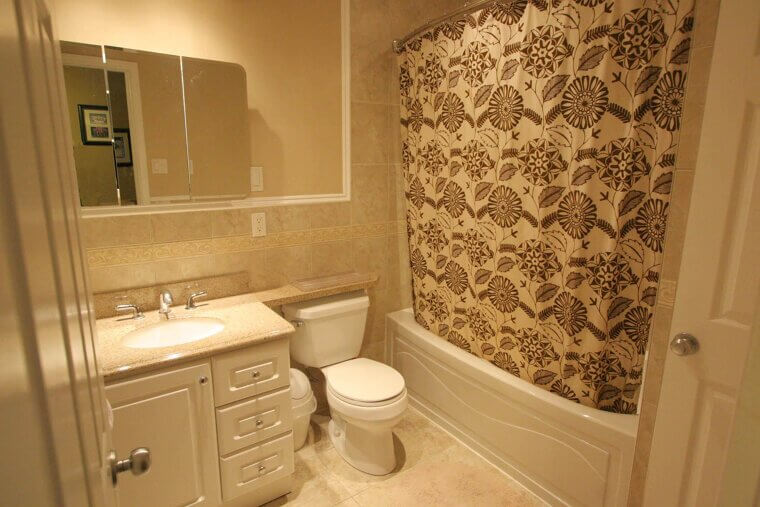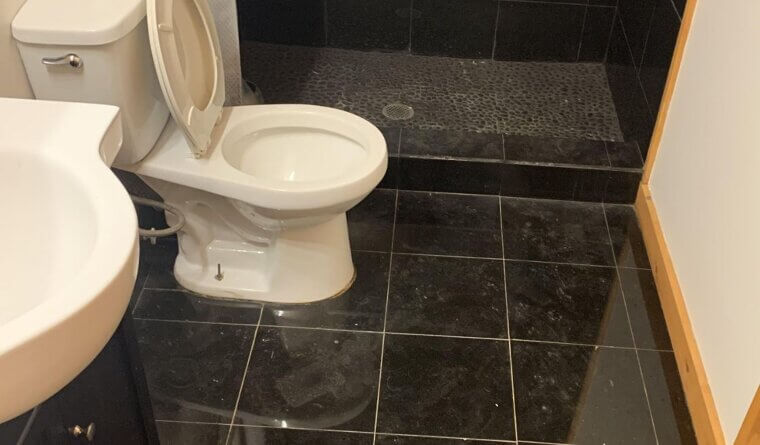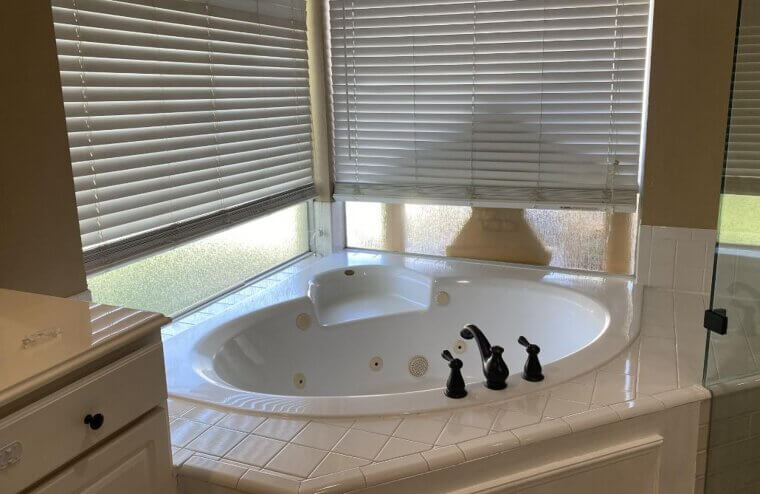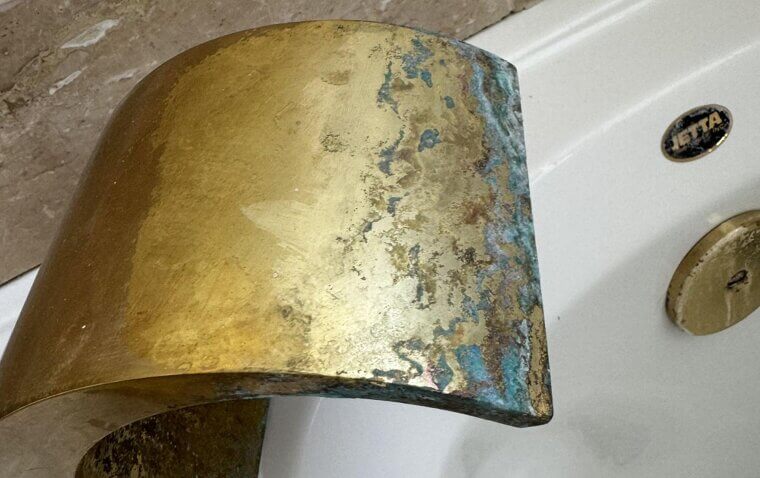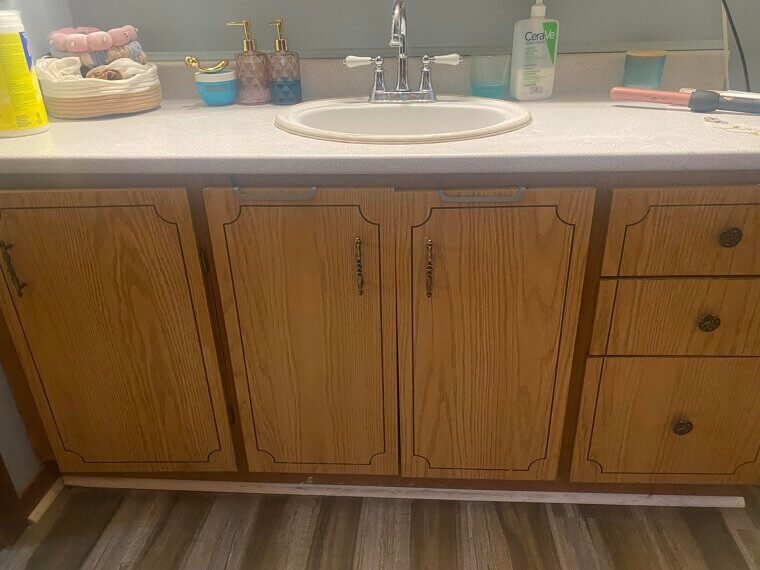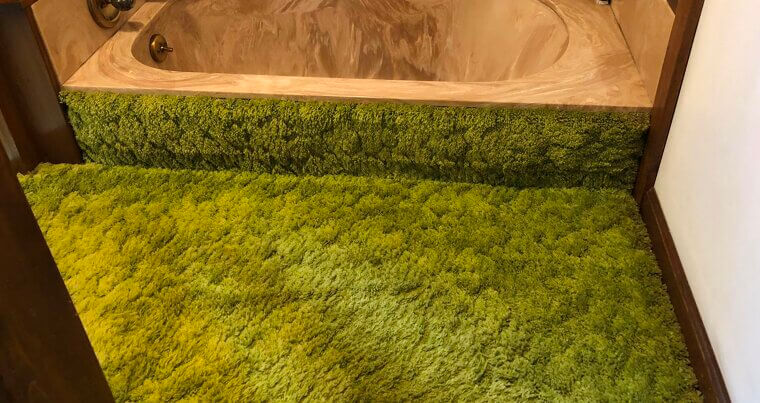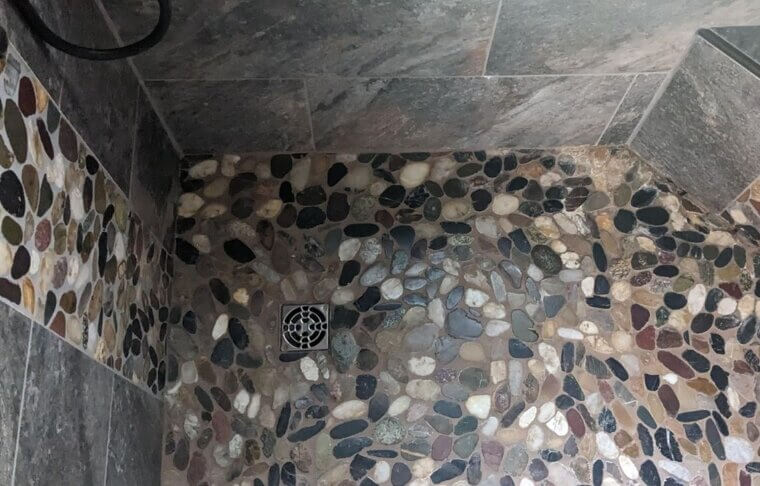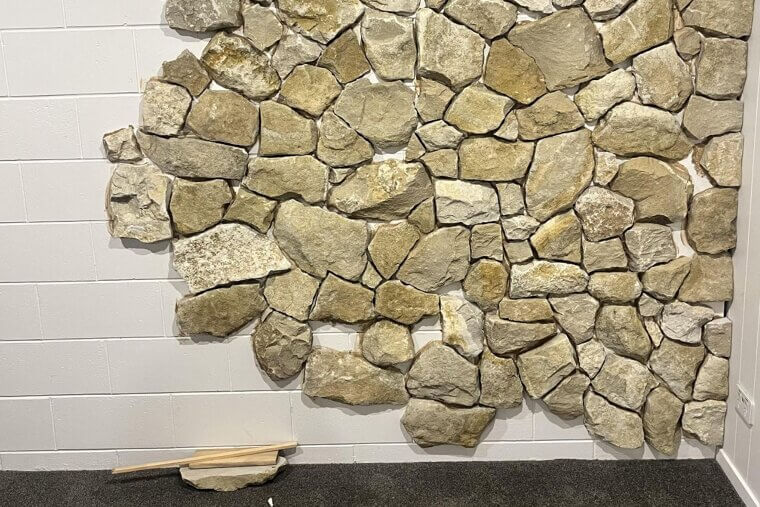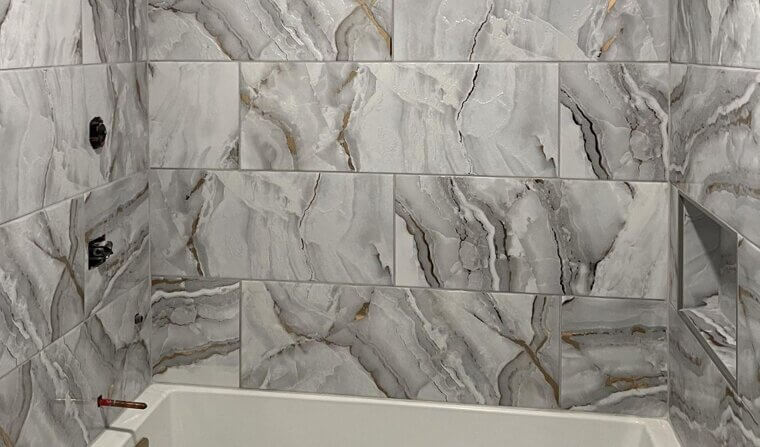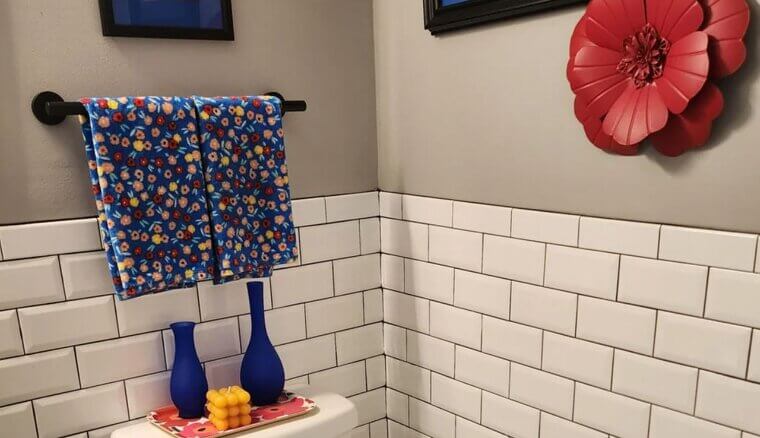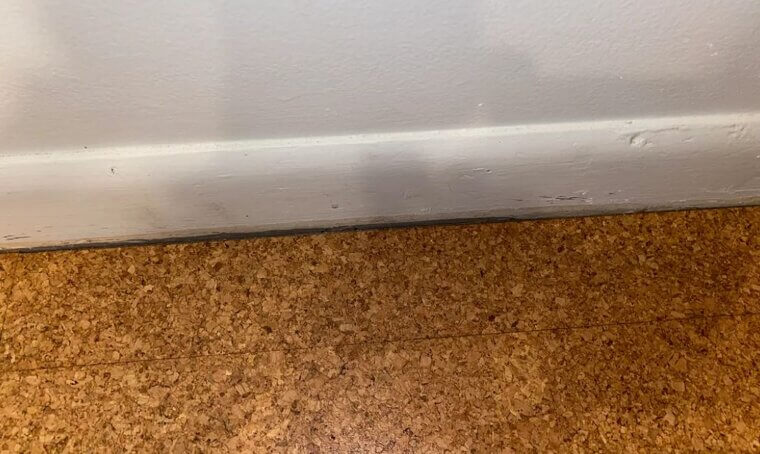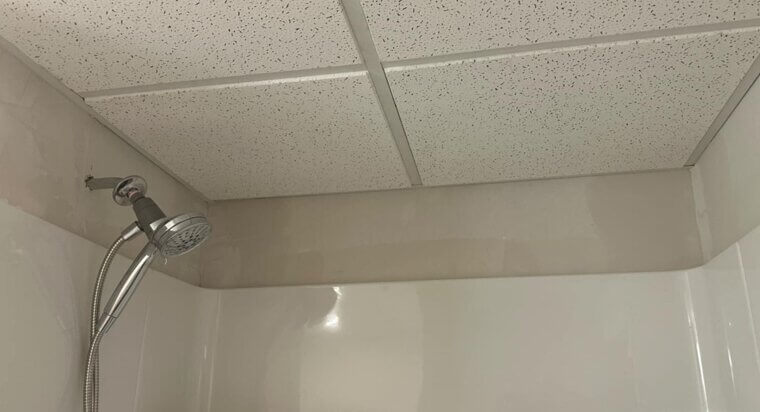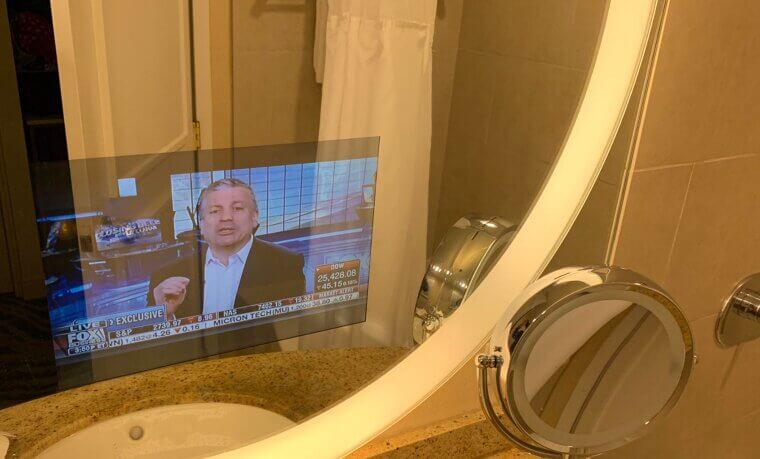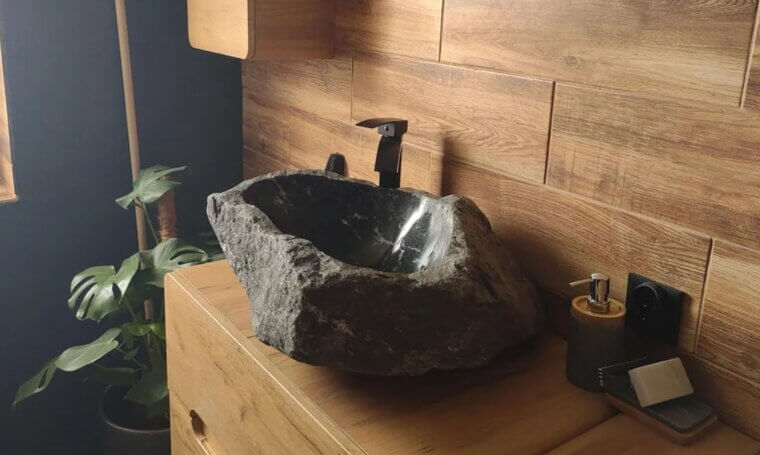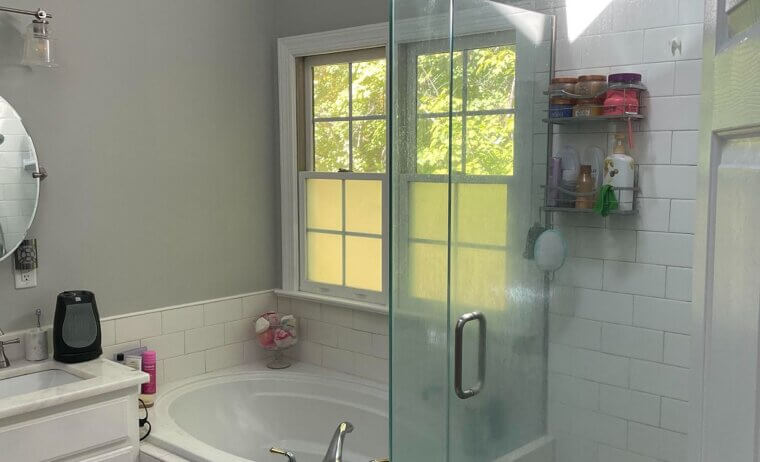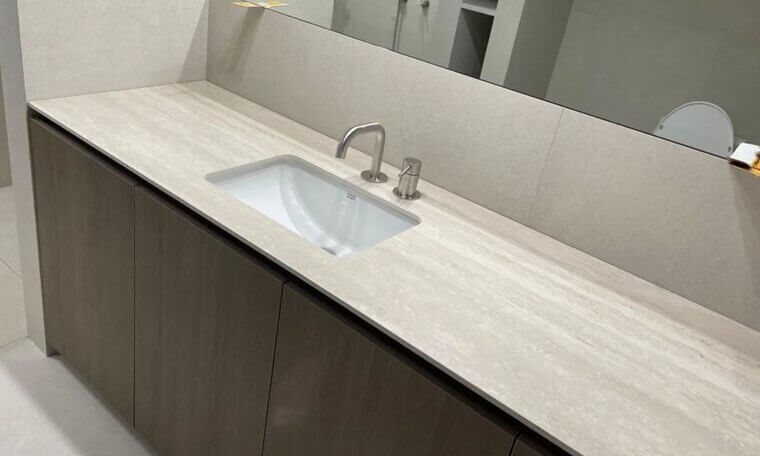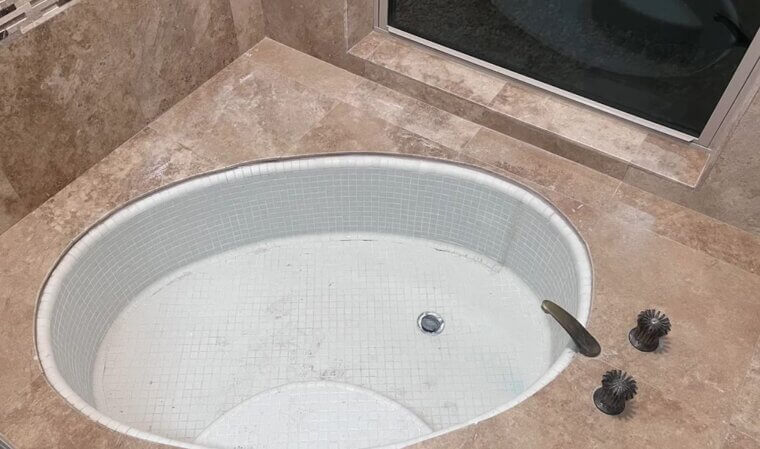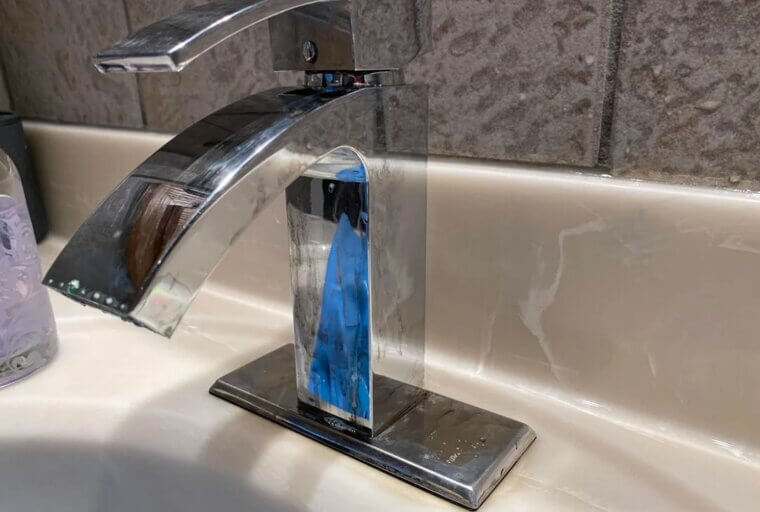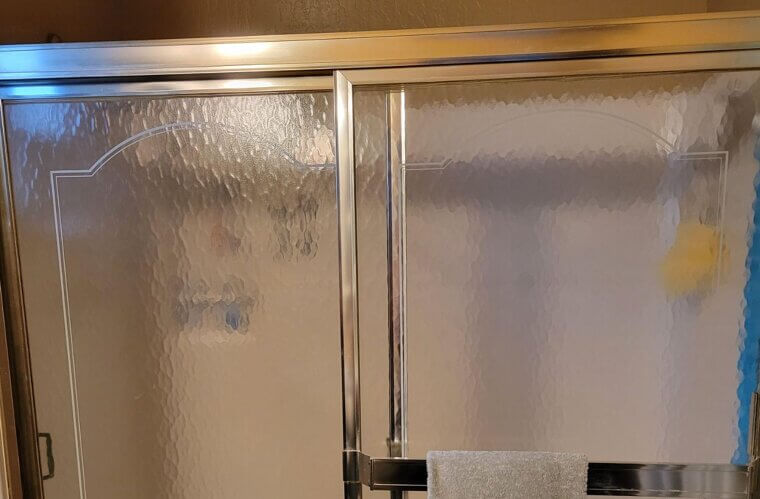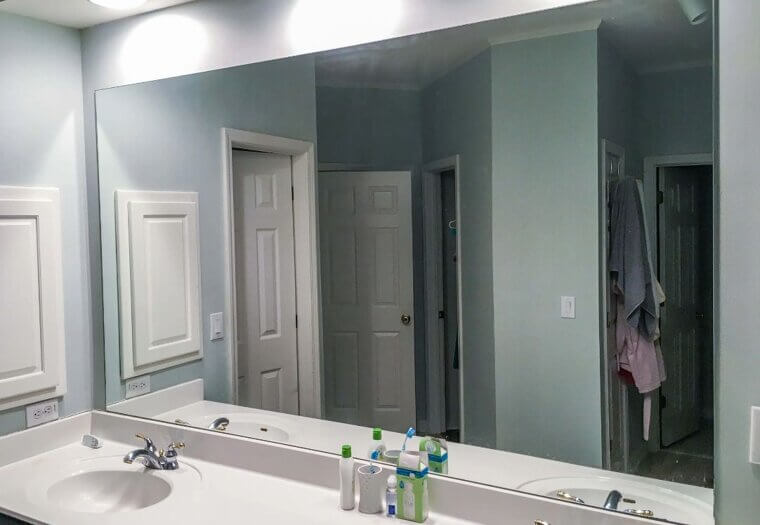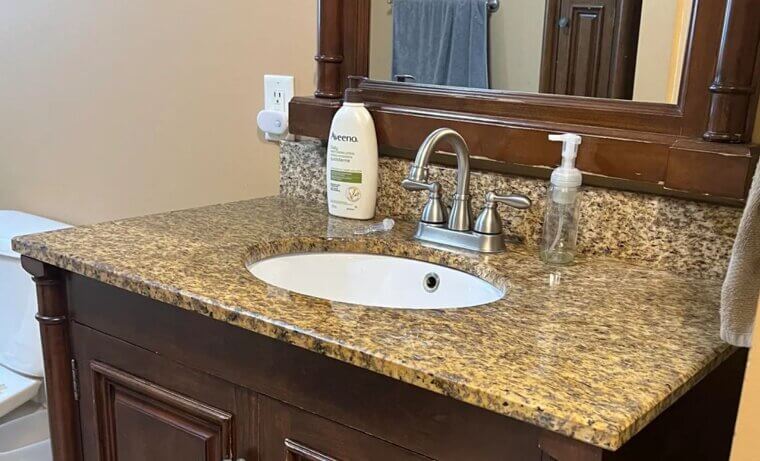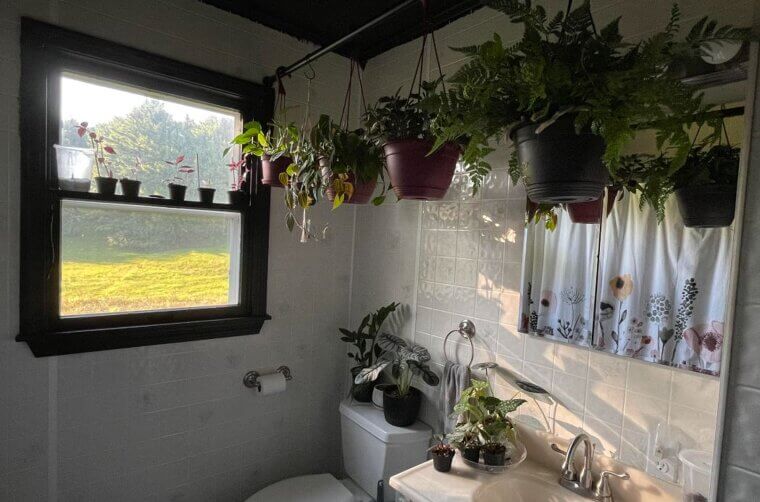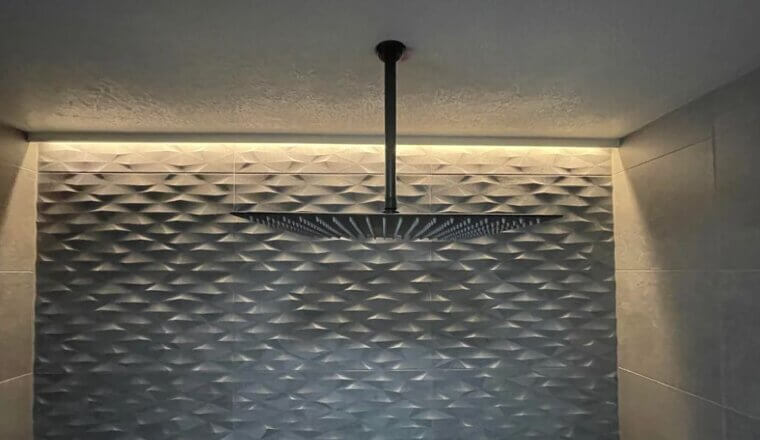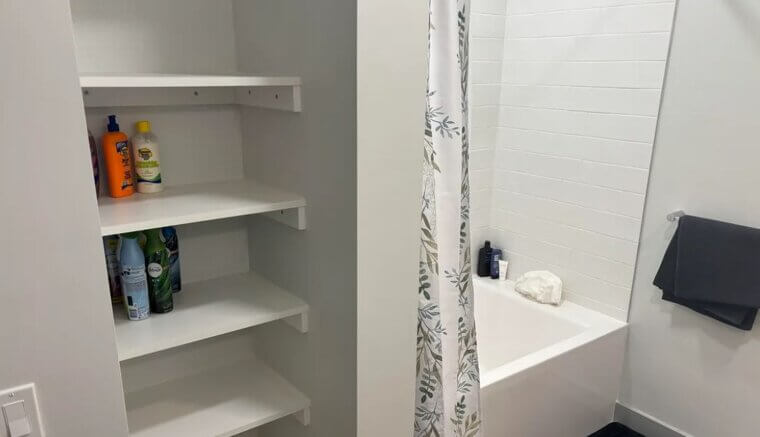Not so Luxurious Anymore
Some bathroom trends once felt like the pinnacle of luxury, transforming ordinary spaces into spa-like sanctuaries. But as design preferences shifted and materials evolved, many of those once-coveted features now feel dated or even impractical. From over-the-top finishes to trends that sacrificed function for style, these bathroom ideas didn’t stand the test of time.
Once considered symbols of sophistication, these bathroom trends have lost their charm and in some cases, even lower a home’s appeal. See which once-luxurious designs now make bathrooms look stuck in the past.
Retro Patterned Tiles
Once hailed as a statement of opulence, retro patterned tiles like these were the epitome of luxury in bathroom design. Their intricate designs and bold colors made them a favorite choice for those wanting to make a dramatic impact. However, as design trends evolved, these tiles began to feel busy and overwhelming. The loud patterns can clash with modern minimalist aesthetics, and their maintenance often proves cumbersome, detracting from their initial appeal.
Although once a trendsetter, these tiles now struggle to adapt to contemporary design sensibilities. Their maintenance demands and outdated look make them less than ideal for modern homes.
Green Whirlpool Tubs
Once a hallmark of opulent bathroom design, green whirlpool tubs promised a luxurious spa experience right at home. However, this dated color choice, paired with bulky designs, quickly fell out of favor. The maintenance of these tubs often proved challenging, with jets prone to clogging and surfaces difficult to clean. A once-stylish trend now feels cumbersome and outdated, overshadowed by sleeker, more minimalist options in contemporary bathrooms.
For those considering a bathroom renovation, opting for a more neutral or timeless design can ensure longevity. Modern alternatives offer improved functionality and style.
Vessel Sinks
Vessel sinks were once the epitome of modern bathroom design, offering a sleek and stylish aesthetic. However, their impracticality soon became evident. These sinks often lead to water splashing over the edges, requiring frequent cleaning of surrounding surfaces. Additionally, their height can be awkward for daily use, and the trend sacrifices functionality for its striking appearance. Over time, the appeal faded as practicality took precedence over style preferences.
For those seeking style and functionality, opting for more integrated sink designs has become the modern choice, leaving vessel sinks in the past.
Glass Block Walls
Glass block walls were once synonymous with high-end bathroom design, offering a unique blend of privacy and natural light. Their aesthetic appeal promised a modern, airy feel to any space. However, as time went on, these heavy installations became cumbersome and dated. Cleaning between the blocks proved challenging, and the limited design flexibility hindered updates. Today, they often clash with more streamlined, contemporary styles.
In today's design world, versatility and ease of maintenance reign supreme. Glass block walls, with their rigid structure and dated appearance, have lost their luster as a viable bathroom trend.
Floral Shower Curtains
Once considered the height of bathroom elegance, floral shower curtains added a splash of personality to otherwise neutral spaces. Their intricate patterns and bold colors seemed refreshing at first, offering an inviting, cozy vibe. However, as minimalist and sleek designs gained popularity, these curtains quickly lost their charm. Their busy patterns can make bathrooms feel cramped and outdated, clashing with modern aesthetics. Additionally, maintaining their cleanliness and vibrancy can be an ongoing hassle.
In today's bathrooms, simplicity reigns supreme, leaving floral shower curtains in the past. Opting for neutral or clear alternatives can instantly modernize a space.
Glossy Black Tiles
Glossy black tiles once exuded a sense of opulence, turning bathrooms into sleek sanctuaries. However, their reflective surface easily shows water spots and smudges, making maintenance a constant battle. The dark color can also make small spaces feel even smaller, lacking the inviting warmth many desire today. As trends lean toward lighter, natural finishes, these tiles now seem more high-maintenance than luxurious. What once felt chic now feels cumbersome.
Embracing trends that prioritize both aesthetics and practicality is essential. Thoughtful design choices that blend style with ease of maintenance create spaces that endure.
Jacuzzi Tubs
Once viewed as the ultimate luxury, Jacuzzi tubs promised a spa-like escape within the confines of your home. These oversized tubs, often equipped with jets, seemed like the perfect way to unwind after a long day. However, they have now become symbols of impracticality, with maintenance issues and high water usage. Modern homeowners often find them cumbersome, leading to their decline in popularity. As design trends favor minimalism, these tubs feel out of place.
In today’s design landscape, Jacuzzi tubs are often replaced with sleek, efficient alternatives. The trend towards simplicity has rendered these once-coveted features obsolete.
Chandelier Overload
Once the epitome of luxury, chandeliers in bathrooms seemed to add a touch of elegance and grandeur. However, as design sensibilities evolved, these extravagant light fixtures started feeling out of place in such functional spaces. Rather than enhancing the room, they often appear cumbersome and impractical, clashing with modern minimalist aesthetics. The maintenance and cleaning involved further detract from their initial allure, making them a trend that has not aged gracefully.
Ultimately, bathroom chandeliers have become a relic of past design excess. Their impracticality and maintenance demands overshadow their once luxurious appeal.
Gold Fixtures
Once seen as the epitome of opulence, gold bathroom fixtures promised to elevate any space to a regal sanctuary. Their shiny, reflective surfaces captured the imaginations of homeowners seeking luxury. However, over time, these fixtures can tarnish and corrode, losing their initial sparkle and allure. Maintenance becomes a battle, as frequent cleaning is necessary to preserve their appearance. Ultimately, the glamour they offer fades, leaving a dated look behind.
As trends evolved, the appeal of gold fixtures diminished. They now often clash with modern aesthetics, highlighting their impracticality and maintenance challenges.
Minimalist White Tiles
Once hailed as the epitome of sleek, modern design, minimalist white tiles in bathrooms were a must-have for their clean and bright appearance. These tiles were thought to open up spaces, making them feel larger and more inviting. However, they quickly revealed their impracticality, as they easily showed dirt and required constant upkeep. The starkness also became synonymous with sterility, lacking the warmth and character many now crave.
While minimalist white tiles seemed like a timeless choice, they often left spaces feeling cold and unwelcoming. Today's trends favor warmth and character, moving away from this once-popular style.
Oak Vanity Cabinets
Oak vanity cabinets were once seen as the height of bathroom luxury, offering a warm, traditional charm. However, as design tastes evolved, these cabinets began to feel outdated and bulky. The heavy wood grain and ornate details clash with today’s sleek, minimalist trends. Additionally, the maintenance required to keep them looking pristine can be a hassle. What once felt sophisticated now feels more like a relic of past design choices.
In modern bathrooms, these cabinets often feel out of place, overshadowed by more contemporary materials and styles. A shift towards lighter, more airy designs has left them behind.
Shag Carpet Catastrophe
Once hailed as the epitome of coziness, shag carpeting in bathrooms promised to bring warmth and luxury to a typically cold space. However, as time passed, the impracticality of this trend became glaringly obvious. Carpets in bathrooms are prone to moisture retention, leading to mold and unpleasant odors. Furthermore, the once-fashionable shag look now feels dated and out of place, highlighting how this trend didn't withstand the test of time.
In retrospect, the shag carpet bathroom trend sacrificed practicality for fleeting style. Modern designs have moved towards easy-to-clean, moisture-resistant materials that prioritize hygiene and aesthetics.
Pebble Shower Floors
Pebble shower floors, once hailed for bringing a natural spa-like feel to bathrooms, have lost their charm over time. Initially admired for their organic look and tactile appeal, they’ve proven to be less practical. The uneven surface can be uncomfortable underfoot and a nightmare to clean, collecting grime far too easily. As grout becomes discolored and pebbles loosen, the maintenance outweighs their aesthetic benefits.
While pebble shower floors may evoke nature, practicality can't be ignored. Modern alternatives offer easier cleaning and maintenance, ensuring longevity and comfort without sacrificing style.
Stone Accent Walls
Once a symbol of luxury, stone accent walls were designed to bring a touch of nature indoors, creating a rustic charm in bathrooms. However, their bulky appearance quickly became outdated as minimalist and sleek designs took over. The maintenance of these walls also proved challenging, with grout cleaning becoming a cumbersome task. Additionally, the heavy materials often led to impractical installations, making them less appealing in modern homes.
While initially appealing, stone accent walls have fallen out of favor due to their impracticality and high maintenance. Modern design trends now favor simplicity and ease of upkeep.
Marble Overload
In the quest for opulence, marble overload became a popular choice in bathroom designs. The extensive use of marble slabs suggested luxury but quickly turned overwhelming. The heavy patterns and cool tones often made these spaces feel cold and busy rather than serene. As design trends shifted toward minimalism, the once-desirable marble-heavy look began to feel outdated. Now, simpler and more balanced designs are preferred.
While once considered a luxury statement, overuse of marble now feels excessive. Modern preferences lean toward subtlety and warmth, leaving the older heavy marble styles behind.
Floral Towel Décor
The once-trendy floral towel décor aimed to bring a splash of color and personality to bathrooms. However, the bold patterns and vivid hues quickly became overwhelming rather than relaxing. Initially seen as a cheerful design choice, these eye-catching towels often clashed with other elements of the room. Over time, they were replaced by more subtle and cohesive bathroom aesthetics. This trend ultimately sacrificed timeless elegance for fleeting vibrancy.
While they added initial charm, these floral towels now seem mismatched and outdated. Opting for neutral tones and minimal patterns offers a more enduring and versatile bathroom style.
Cork Flooring
Cork flooring in bathrooms once symbolized an eco-friendly luxury, offering a warm, soft touch underfoot. Initially praised for its sustainability and natural look, it quickly fell out of favor due to its susceptibility to water damage. The material often absorbs moisture, leading to swelling and mold issues, making maintenance a hassle. As waterproof options became more popular, cork's appeal diminished, showcasing its impracticality in wet areas.
Despite its initial allure, cork flooring's inability to handle moisture well led to its decline in bathroom design. Today, more durable materials provide both style and practicality.
Drop Ceiling Showers
Drop ceilings in showers were once considered a clever way to hide plumbing and wiring while giving bathrooms a polished look. However, as time passed, these structures became notorious for moisture issues and mold growth. Their dated appearance clashes with modern sleek designs, making them a less appealing choice today. The practical drawbacks now outweigh the initial aesthetic appeal, leading many to seek alternative solutions for a more open and airy feel.
Overall, the impracticality and outdated look of shower drop ceilings have led to their decline in popularity, making way for more contemporary and efficient designs.
TV Mirrors
Once thought to elevate the bathroom experience, TV mirrors combined entertainment with grooming spaces, promising a touch of modern luxury. However, as technology advanced, these mirrors now feel more like a relic of the past. They're often criticized for their poor screen quality and the distracting presence they introduce into a space meant for relaxation. Moreover, their maintenance and repair can be cumbersome. As styles evolve, simplicity often triumphs over such gimmicks.
For today's tech-savvy homes, streamlined designs and multifunctional gadgets have taken the lead. The once-coveted TV mirrors now find themselves overshadowed by more practical and elegant solutions.
Stone Vessel Sink
Stone vessel sinks once epitomized high-end bathroom design with their organic and artisanal appeal. Their rugged texture and unique presence made them a favorite for those seeking to elevate their space with a natural touch. However, as time went on, their impracticalities became apparent. They require special maintenance and can be prone to chipping, making them less ideal for everyday use. Today, they often feel bulky and challenging to clean.
Ultimately, the allure of stone vessel sinks faded as practicality and ease of maintenance gained priority in modern bathroom trends.
Glass Block Showers
The glass block shower was once hailed as a luxurious addition, offering a sleek, modern look with its transparent and frosted design. However, this trend quickly became dated as cleaning challenges arose. The blocks could be difficult to maintain, with grime accumulating in the grout lines over time. Additionally, the bulky appearance of these showers often overwhelmed smaller spaces, making them less practical. Today's designs favor sleek, frameless glass for a more timeless look.
In the end, glass block showers sacrificed practicality for style. As maintenance issues and aesthetic preferences shifted, they fell out of favor in modern bathroom designs.
Minimalist Vanities
Once hailed for their sleek and clean lines, minimalist vanities with integrated sinks were a hallmark of modern luxury. Designed to maximize space and maintain a clutter-free environment, they seemed like an ideal choice for contemporary homes. However, as trends evolved, the lack of storage became a major drawback. The integrated sink, while visually appealing, often proved less practical for cleaning and maintenance. Today, homeowners lean towards more functional designs.
The quest for simplicity sometimes overlooked practicality. As storage needs increased, these vanities struggled to keep pace, leading to a shift towards more versatile solutions.
Sunken Tubs
Once a hallmark of luxurious bathroom design, sunken tubs offered a unique and sophisticated bathing experience. However, they’ve become less desirable due to practical concerns. These tubs can be awkward to access, posing potential safety hazards. Additionally, their recessed design often makes cleaning and maintenance more challenging. Modern homeowners tend to favor ease of use and functionality over this once-glamorous feature. This trend, though stylish in its time, has aged poorly.
Today, practicality and safety take priority in bathroom design. The allure of sunken tubs has faded, replaced by more accessible and user-friendly options that meet contemporary needs.
Pink Marble Overload
Once considered the epitome of opulence, pink marble was a popular choice for creating an extravagant bathroom look. Its rich color and intricate veining provided a sense of elegance and sophistication. However, over time, this trend has become synonymous with outdated design. The overwhelming use of pink can make the space feel claustrophobic and uninviting. Modern tastes favor neutral tones and minimalism, leaving this once-loved finish behind.
Today’s bathrooms lean towards subtle elegance and functionality, making pink marble feel out of place. Simplicity and versatility have replaced the flashy opulence of the past.
Ceiling Fans
Ceiling fans in bathrooms once represented a chic blend of function and style, offering a way to cool and circulate air. However, they’ve fallen out of favor due to practicality concerns. Bathrooms are generally humid environments, and ceiling fans can struggle to handle excess moisture, leading to damage over time. Today, more efficient and moisture-resistant ventilation options are preferred, making these fans an outdated choice.
In modern design, smaller and more efficient ventilation solutions have taken over, rendering bathroom ceiling fans largely obsolete. The emphasis now is on sleek, space-saving designs.
Waterfall Faucets
Waterfall faucets once epitomized bathroom luxury with their sleek, modern design and the calming sound of flowing water. However, these stylish fixtures often fell short in practicality. Their open spouts can lead to water splashing onto countertops, creating constant cleaning hassles. Over time, mineral buildup and water stains become more noticeable, diminishing their visual appeal. As trends shifted toward efficiency and minimalism, the waterfall faucet's high-maintenance nature became increasingly apparent.
Ultimately, while waterfall faucets began as a symbol of elegance, their impracticality led to their decline. Modern designs favor functionality and ease, leaving these faucets in the past.
Shower Doors
Once seen as the epitome of sleek design, framed shower doors with textured glass quickly became popular. They promised a modern and clean look, adding visual interest to any bathroom. However, their intricate frames and textured surfaces now feel cumbersome and difficult to maintain. They tend to trap dirt and grime, making them less practical. The trend has shifted towards frameless and clear glass doors for a more open, airy feel.
Today's bathrooms favor ease and simplicity, making these framed, textured shower doors a relic of the past. As design principles evolve, homeowners seek more streamlined and functional options.
Massive Wall Mirrors
Once the symbol of elegance and spaciousness in bathrooms, massive wall mirrors have fallen out of favor. They were initially popular for their ability to create an illusion of a larger space, but they now feel overwhelming and outdated. Their size makes them difficult to clean, often showing unsightly streaks. Additionally, they lack personality and customization options, failing to add warmth or character to the room. Modern trends prefer more unique and functional alternatives.
Revamping with smaller, stylish mirrors can bring personality back to your bathroom. Consider adding frames or unique shapes to create a more contemporary, appealing look.
Granite Countertops
Once hailed as the ultimate in bathroom luxury, granite countertops offered a touch of opulence with their rich patterns and durable surface. However, as design trends shifted towards minimalism and sustainability, granite began to feel heavy and outdated. The high maintenance required to keep it pristine, along with susceptibility to staining, made it less appealing over time. Today, many homeowners prefer lighter, eco-friendly materials that offer both style and practicality.
While granite once symbolized luxury, its cumbersome maintenance and dated look have led to its decline. As preferences move towards simplicity and eco-friendliness, granite’s star has dimmed.
Hanging Plants Overload
Hanging plants in the bathroom once offered a lush, spa-like atmosphere, transforming the space into a green oasis. Initially, this verdant trend seemed like the ultimate luxury, adding a touch of nature indoors. However, as time passed, the impracticality became evident. Excessive moisture and humidity from showers can lead to mold growth, and maintaining multiple plants is cumbersome. This trend ultimately prioritized aesthetics over practicality, leaving it feeling outdated.
While once a sought-after design, cluttered plant arrangements in the bathroom have proven unsustainable. Modern trends favor simplicity and functionality, making this once-luxurious idea feel outdated and inconvenient.
Rainfall Showerhead
Once hailed as a symbol of luxury, the rainfall showerhead aimed to replicate the calming sensation of natural rain. Initially, it added a spa-like elegance to bathrooms, making them feel indulgently sophisticated. However, over time, these showerheads revealed their downside: water pressure issues and inefficient water use. Today's eco-conscious design favors more efficient alternatives, leaving the rainfall showerhead feeling like a relic of excessive water consumption.
While once a staple of high-end bathroom design, this trend has become impractical. As homeowners prioritize sustainability, the rainfall showerhead no longer fits modern needs.
Open Storage Shelving
Open storage shelves in bathrooms once symbolized a modern, minimalist aesthetic. They promised easy access and a sleek look, but they often led to cluttered and unkempt spaces. The absence of doors made it difficult to hide personal items, detracting from a clean and organized appearance. Dust accumulation became a persistent issue, requiring constant upkeep. Over time, the practicality of this design feature wore thin as preferences leaned toward concealed storage.
Concealed cabinetry not only improves organization but also maintains a tidy, streamlined aesthetic. It's a functional shift that better suits modern lifestyle needs.
Bulky Medicine Cabinets
Once considered the epitome of practicality and luxury, bulky medicine cabinets were a staple in many households. Offering ample storage space for toiletries and medications, they were designed to keep everything within arm's reach. However, their large frames often dominate small spaces, making bathrooms feel cramped and cluttered. As minimalist trends took over, these oversized cabinets quickly fell out of favor, replaced by sleek, hidden storage solutions that maximize space.
As design tastes evolved, the trend of bulky medicine cabinets faded, giving way to more streamlined alternatives. Modern bathrooms now prioritize space efficiency and aesthetics.
Ceramic Soap Holders
Ceramic soap holders were once a staple of luxury bathrooms, providing a dedicated spot for bars of soap. However, as liquid and foaming soaps gained popularity, these built-in features fell out of favor. The design often traps water, leading to a messy and unhygienic appearance. Additionally, their installation requires cutting into the tile, making replacements or updates challenging. Today, they are seen as outdated and impractical.
As modern bathrooms embrace sleek minimalism, ceramic soap holders have been left behind. Freestanding or wall-mounted dispensers offer more versatility and cleanliness.

